Air-Stable and Eco-Friendly Symmetrical Imine with Thiadiazole Moieties in Neutral and Protonated form for Perovskite Photovoltaics
Abstract
:1. Introduction
2. Experimental Section
General Synthesis of Imine
3. Results and Discussions
3.1. Synthesis and Purification of Imine
3.2. Imine Protonation with Camphorosulfonic Acid Enantiomers
3.3. Optical and Electrochemical Studies
3.4. Thermal and Electrical Properties
3.5. Durability at Ambient Conditions and Prices of PPL2
4. Conclusions
- The synthesis of imine can be performed in a one-step reaction in solution followed by simple purification, which significantly lowers the cost production of the pure product;
- The simplicity of the process allows for the recovery of the used solvent to be reused again in other processes;
- The presence of imine bonds next to the thiadiazole ring resulted in the selective protonation of the structure, namely, the protonation occurs on imine nitrogen;
- The spectral characteristics of PPL2 are almost identical to the spectra of the spiro-OMeTAD commercial compound;
- The addition of the acidic dopant increases the thermal resistance of the synthesised imine PPL2, in some cases up to almost 140 °C.
Author Contributions
Funding
Institutional Review Board Statement
Informed Consent Statement
Data Availability Statement
Acknowledgments
Conflicts of Interest
References
- Petrus, M.L.; Bein, T.; Dingemans, T.J.; Docampo, P. A low cost azomethine-based hole transporting material for perovskite photovoltaics. J. Mater. Chem. A 2015, 3, 12159–12162. [Google Scholar] [CrossRef]
- Osedach, T.P.; Andrew, T.L.; Bulović, V. Effect of synthetic accessibility on the commercial viability of organic photovoltaics. Energy Environ. Sci. 2013, 6, 711–718. [Google Scholar] [CrossRef]
- Pitchaiya, S.; Natarajan, M.; Santhanam, A.; Asokan, V.; Yuvapragasam, A.; Ramakrishnan, V.M.; Palanisamy, S.E.; Sundaram, S.; Velauthapillai, D. A review on the classification of organic/inorganic/carbonaceous hole transporting materials for perovskite solar cell application. Arab. J. Chem. 2018, 13, 2526–2557. [Google Scholar] [CrossRef]
- Zhao, X.; Wang, M. Organic hole-transporting materials for efficient perovskite solar cells. Mater. Today Energy 2018, 7, 208–220. [Google Scholar] [CrossRef]
- Assadi, M.K.; Bakhoda, S.; Saidur, R.; Hanae, H. Recent progress in perovskite solar cells. Renew. Sustain. Energy Rev. 2018, 81, 2812–2822. [Google Scholar] [CrossRef]
- Mesquita, I.; Andrade, L.; Mendes, A. Perovskite solar cells: Materials; configurations; stability. Renew. Sustain. Energy Rev. 2018, 82, 2471–2489. [Google Scholar] [CrossRef]
- Yang, X.; Wang, H.; Cai, B.; Yu, Z.; Sun, L. Progress in hole-transporting materials for perovskite solar cells. J. Energy Chem. 2018, 27, 650–672. [Google Scholar] [CrossRef]
- Bakrab, Z.H.; Wali, Q.; Fakharuddin, A.; Schmidt-Mende, L.; Brown, T.M.; Jose, R. Advances in hole transport materials engineering for stable and efficient perovskite solar cells. Nano Energy 2017, 34, 271–305. [Google Scholar] [CrossRef]
- Rodríguez-Seco, C.; Cabau, L.; Vidal-Ferran, A.; Palomares, E. Advances in the Synthesis of Small Molecules as Hole Transport Materials for Lead Halide Perovskite Solar Cells. Acc. Chem. Res. 2018, 51, 869–880. [Google Scholar] [CrossRef]
- Moon, H.C.; Lodge, T.P.; Frisbie, C.D.; Processable, S. Electrochromic Ion Gels for Sub-1 V, Flexible Displays on Plastic. Chem. Mater. 2015, 27, 2990–2997. [Google Scholar] [CrossRef]
- Zhang, F.; Wang, Z.; Zhu, H.; Pellet, N.; Luo, J.; Yi, C.; Liu, X.; Liu, H.; Wang, S.; Li, X.; et al. Over 20% PCE perovskite solar cells with superior stability achieved by novel and low-cost hole-transporting materials. Nano Energy 2017, 41, 469–475. [Google Scholar] [CrossRef]
- Magomedov, A.; Al-Ashouri, A.; Kasparavičius, E.; Strazdaite, S.; Niaura, G.; Jošt, M.; Malinauskas, T.; Albrecht, S.; Getautis, V. Hole Transporting Monolayers: Self-Assembled Hole Transporting Monolayer for Highly Efficient Perovskite Solar Cells (Adv. Energy Mater. 32/2018). Adv. Energy Mater. 2018, 8, 1870139. [Google Scholar] [CrossRef]
- Saliba, M.; Orlandi, S.; Matsui, T.; Aghazada, S.; Cavazzini, M.; Correa-Baena, J.-P.; Gao, P.; Scopelliti, R.; Mosconi, E.; Dahmen, K.-H.; et al. A molecularly engineered hole-transporting material for efficient perovskite solar cells. Nat. Energy 2016, 1, 15017. [Google Scholar] [CrossRef]
- Ma, B.-B.; Zhang, H.; Wang, Y.; Peng, Y.-X.; Huang, W.; Wang, M.-K.; Shen, Y. Visualized acid–base discoloration and optoelectronic investigations of azines and azomethines having double 4-[N,N-di(4-methoxyphenyl)amino]phenyl terminals. J. Mater. Chem. C 2015, 3, 7748–7755. [Google Scholar] [CrossRef]
- Bogdanowicz, K.A.; Jewłoszewicz, B.; Iwan, A.; Dysz, K.; Przybyl, W.; Januszko, A.; Marzec, M.; Cichy, K.; Świerczek, K.; Kavan, L.; et al. Selected electrochemical properties of 4,4’-((1E,1’E)-((1,2,4-thiadiazole-3,5-diyl)bis(azaneylylidene)) bis(methaneylylidene))bis(N, N-di-ptolylaniline) towards perovskite solar cells with 14.4% efficiency. Materials 2020, 13, 2440. [Google Scholar] [CrossRef] [PubMed]
- Gawlinska, K.; Iwan, A.; Starowicza, Z.; Kulesza-Matlak, G.; Stan-Glowinska, K.; Janusz, M.; Lipinski, M.; Boharewicz, B.; Tazbir, I.; Sikora, A. Searching of new; cheap, air- and thermally stable hole transporting materials for perovskite solar cells. Opto-Electron. Rev. 2017, 25, 274–284. [Google Scholar] [CrossRef]
- Bogdanowicz, K.A.; Przybył, W.; Dysz, K.; Dylong, A.; Gnida, P.; Schab-Balcerzak, E.; Kaim, A.; Iwan, A. Influence of imine symmetry and triphenylamine moieties on photovoltaic properties of BHJ organic solar cells. Mater. Sci. Eng. B 2023, 296, 116701. [Google Scholar] [CrossRef]
- Zweckmair, T.; Hell, S.; Klinger, K.M.; Rosenau, T.; Potthast, A.; Böhmdorfer, S. Recycling of Analytical Grade Solvents on a Lab Scale with a Purpose-Built Temperature-Controlled Distillation Unit. Org. Process Res. Dev. 2017, 21, 578–584. [Google Scholar] [CrossRef]
- Iwan, A.; Boharewicz, B.; Tazbir, I.; Filapek, M.; Korona, K.P.; Wróbel, P.; Stefaniuk, T.; Ciesielski, A.; Wronowska, A.A.; Wronowski, A.; et al. How do, silver or aluminum nanoparticles influence optical, electrochemical, electrochromic and photovoltaic properties of air and thermally stable triphenylamine-based polyazomethine with carbazole moieties? Electrochim. Acta 2015, 185, 198–210. [Google Scholar] [CrossRef]
- Lee, K.; Yu, H.; Lee, J.W.; Oh, J.; Bae, S.; Kim, S.K.; Jang, J. Efficient and moisture-resistant hole transport layer for inverted perovskite solar cells using solution-processed polyaniline. J. Mater. Chem. C 2018, 6, 6250–6256. [Google Scholar] [CrossRef]
- Zubert, I.V.; Vergizov, S.N.; Yakovlev, S.I.; V’yunov, K.A. Besicity and mechanism of transmission of electronic effect of substituents in the series of 2-amino-5aryl-1,3,4-thiadiazoles. Chem. Heterocycl. Compd. 1987, 23, 225–228. [Google Scholar]
- Serban, G.; Stanasel, O.; Serban, E.; Bota, S. 2-Amino-1, 3, 4-thiadiazole as a potential scaffold for promising antimicrobial agents. Drug design, development and therapy. Drug Des. Dev. Ther. 2018, 12, 1545–1566. [Google Scholar] [CrossRef] [PubMed]
- Bujak, P.; Kulszewicz-Bajer, I.; Zagorska, M.; Maurel, V.; Wielgus, I.; Pron, A. Polymers for electronics and spintronics. Chem. Soc. Rev. 2013, 42, 8895–8999. [Google Scholar] [CrossRef] [PubMed]
- Kurowska, A.; Kostyuchenko, A.S.; Zassowski, P.; Skorka, L.; Yurpalov, V.L.; Fisyuk, A.S.; Pron, A.; Domagala, W. Symmetrically Disubstituted Bithiophene Derivatives of 1,3,4-Oxadiazole, 1,3,4-Thiadiazole, and 1,2,4-Triazole—Spectroscopic, Electrochemical, and Spectroelectrochemical Properties. J. Phys. Chem. C 2014, 118, 25176–25189. [Google Scholar] [CrossRef]
- Steim, R.; Choulis, S.A.; Schilinsky, P.; Lemmer, U.; Brabec, C.J. Formation and impact of hot spots on the performance of organic photovoltaic cells. Appl. Phys. Lett. 2009, 94, 043304. [Google Scholar] [CrossRef]
- Hepp, J.; Machui, F.; Egelhaaf, H.J.; Brabec, C.J.; Vetter, A. Automatized analysis of IR-images of photovoltaic modules and its use for quality control of solar cells. Energy Sci. Eng. 2016, 4, 363–371. [Google Scholar] [CrossRef]
- Hoppe, H.; Bachmann, J.; Muhsin, B.; Drüe, K.H.; Riedel, I.; Gobsch, G.; Buerhop-Lutz, C.; Brabec, C.J.; Dyakonov, V. Quality control of polymer solar modules by lock-in thermography. J. Appl. Phys. 2010, 107, 014505. [Google Scholar] [CrossRef]
- Bachmann, J.; Buerhop-Lutz, C.; Deibel, C.; Riedel, I.; Hoppe, H.; Brabec, C.J.; Dyakonov, V. Organic solar cells characterized by dark lock-in thermography. Sol. Energy Mater. Sol. Cells 2010, 94, 642–647. [Google Scholar] [CrossRef]
- Różycka, A.; Bogdanowicz, K.A.; Górska, N.; Rysz, J.; Marzec, M.; Iwan, A.; Pich, R.; Januszko, A. Influence of TiO2 Nanoparticles on Liquid Crystalline, Structural and Electrochemical Properties of (8Z)-N-(4-((Z)-(4-pentylphenylimino) methyl)benzylidene)-4-pentylbenzenamine. Materials 2019, 12, 1097. [Google Scholar] [CrossRef]
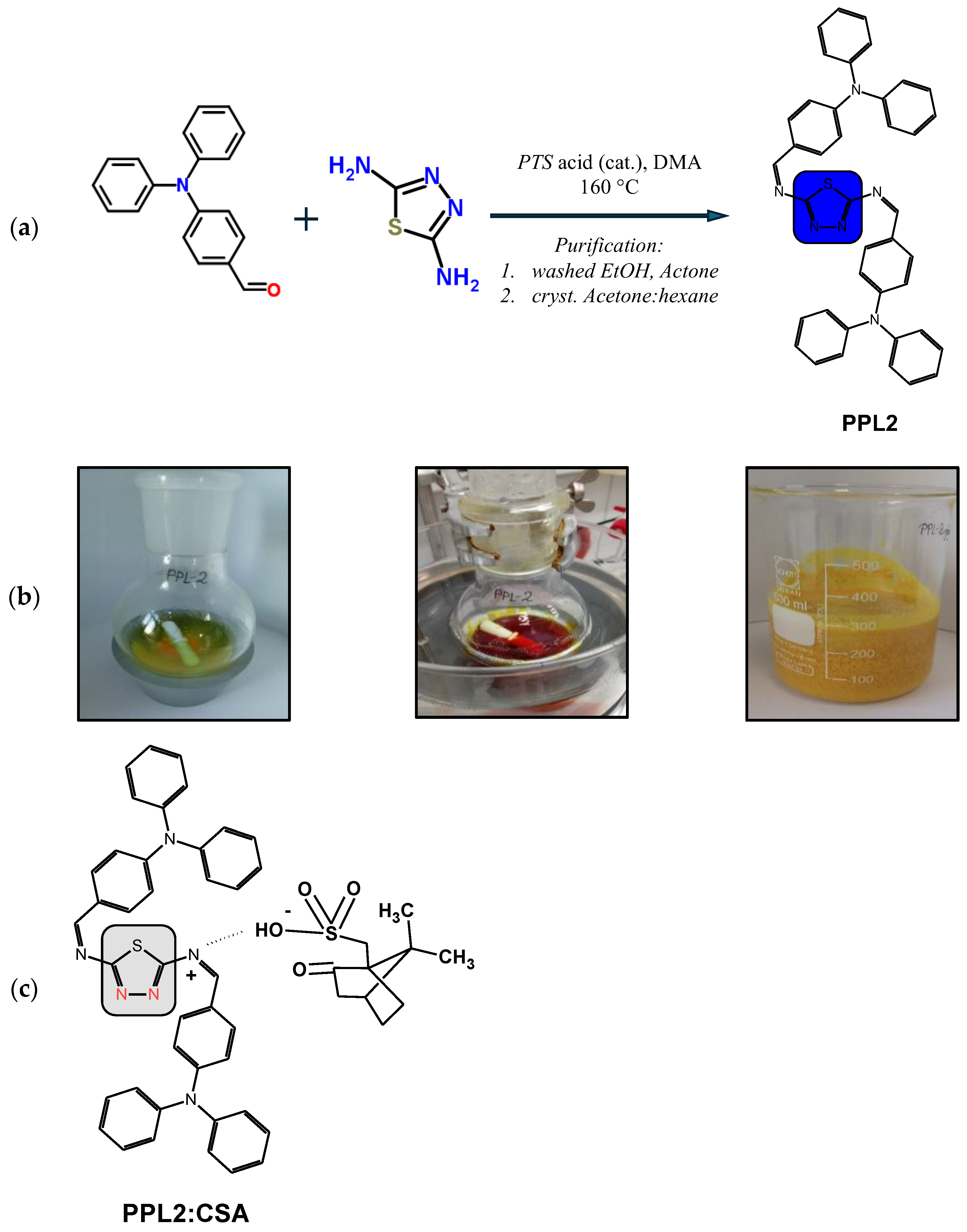
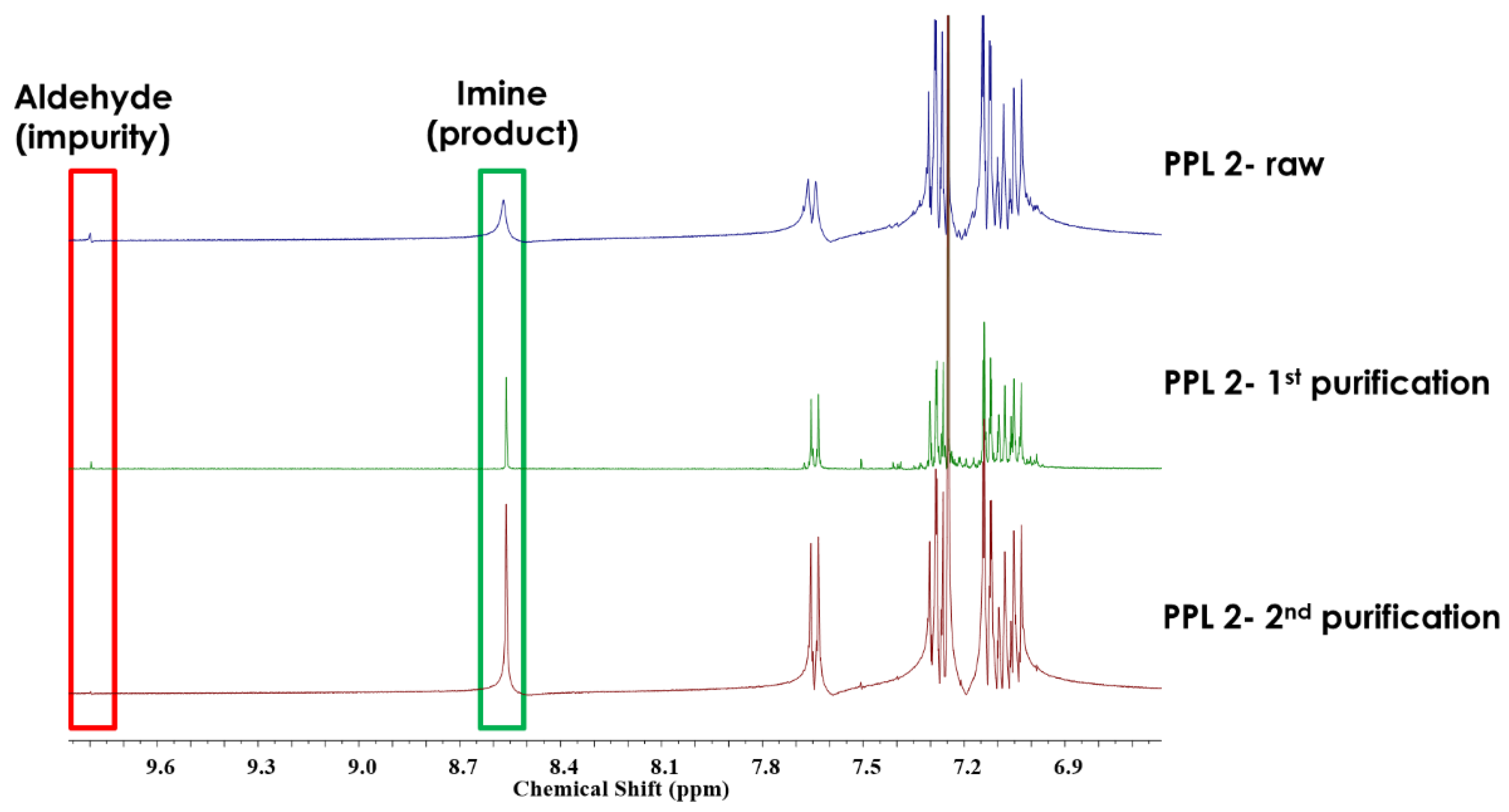
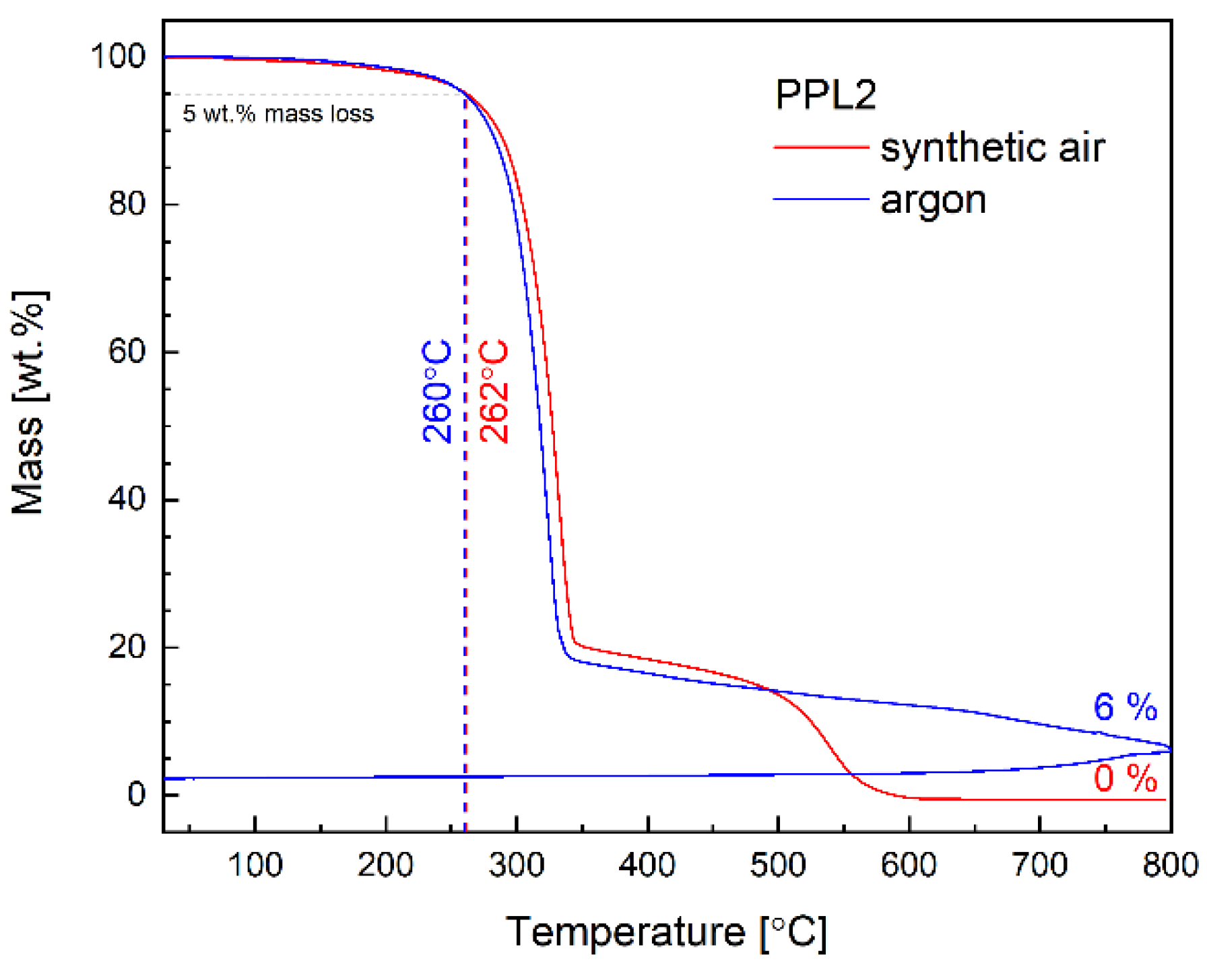
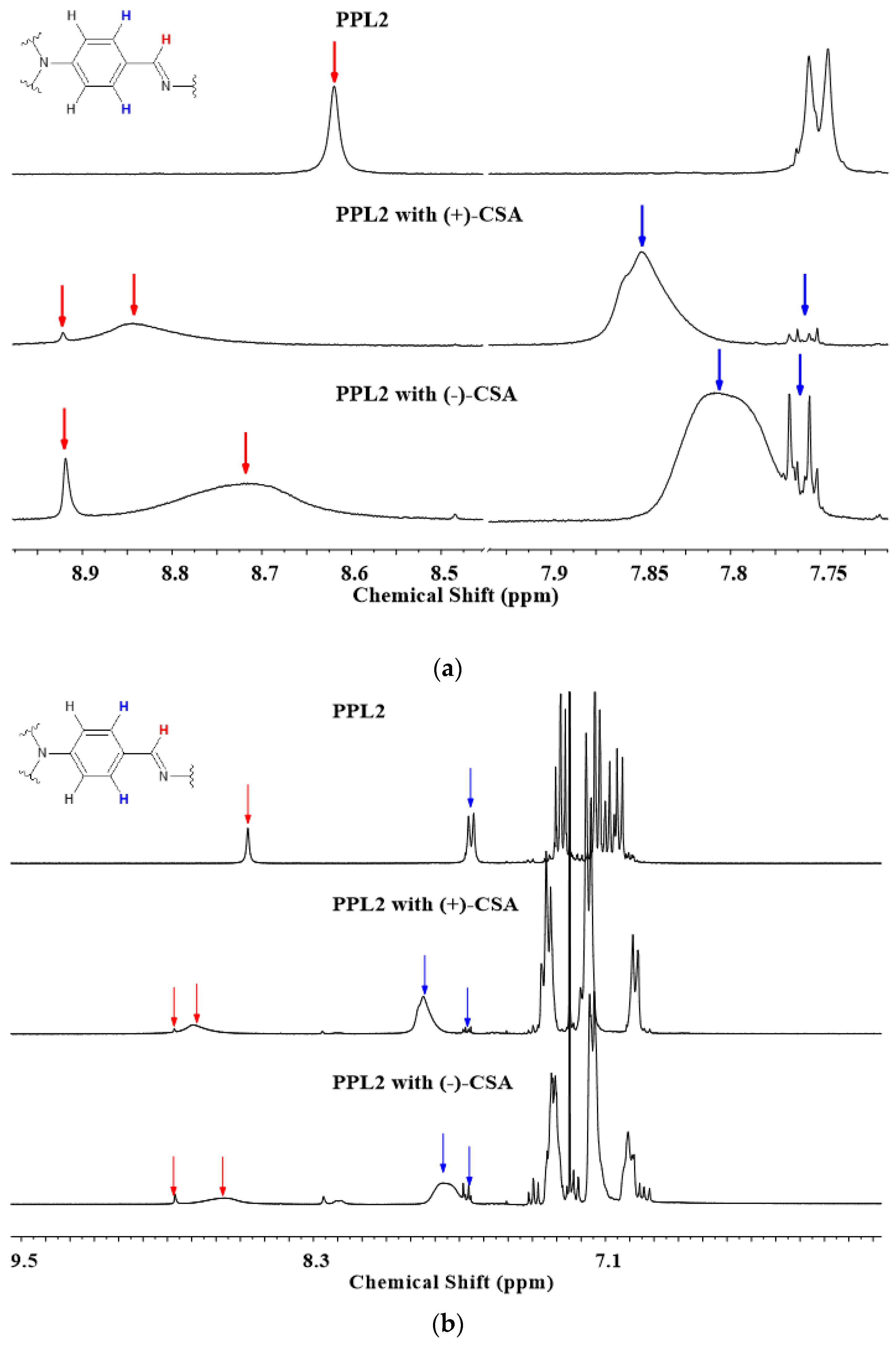


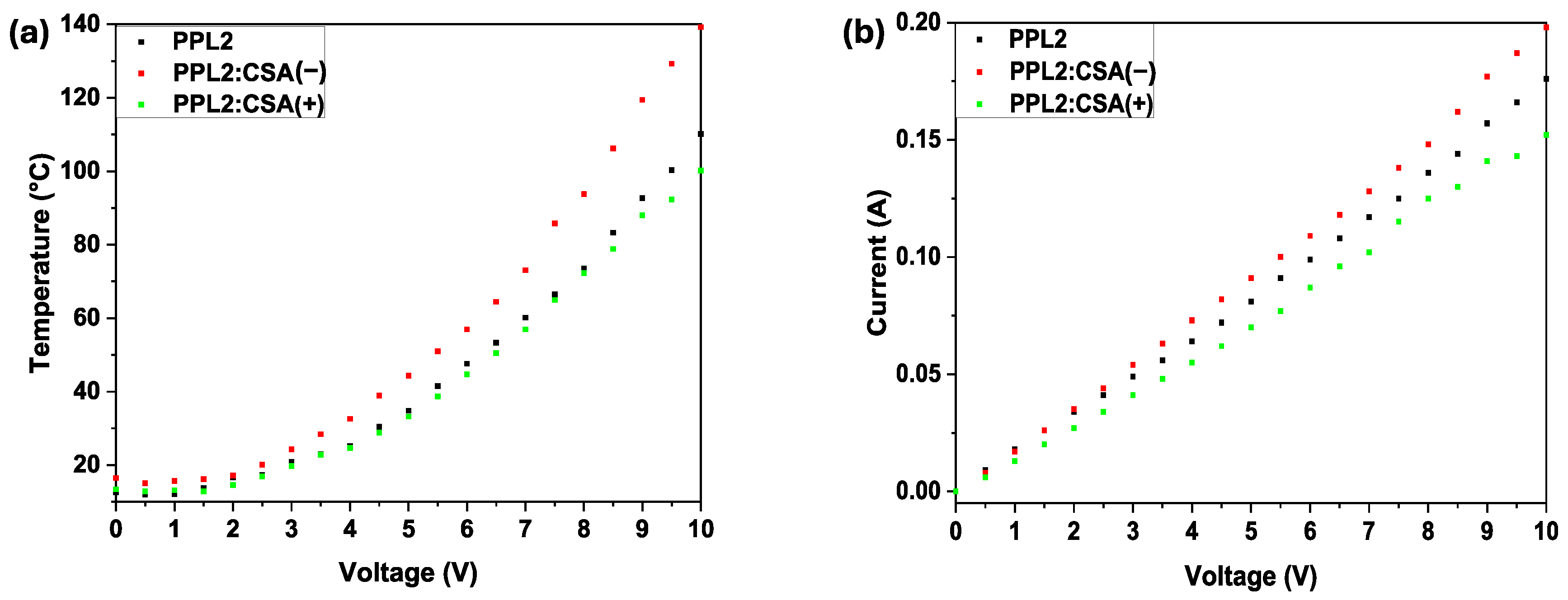
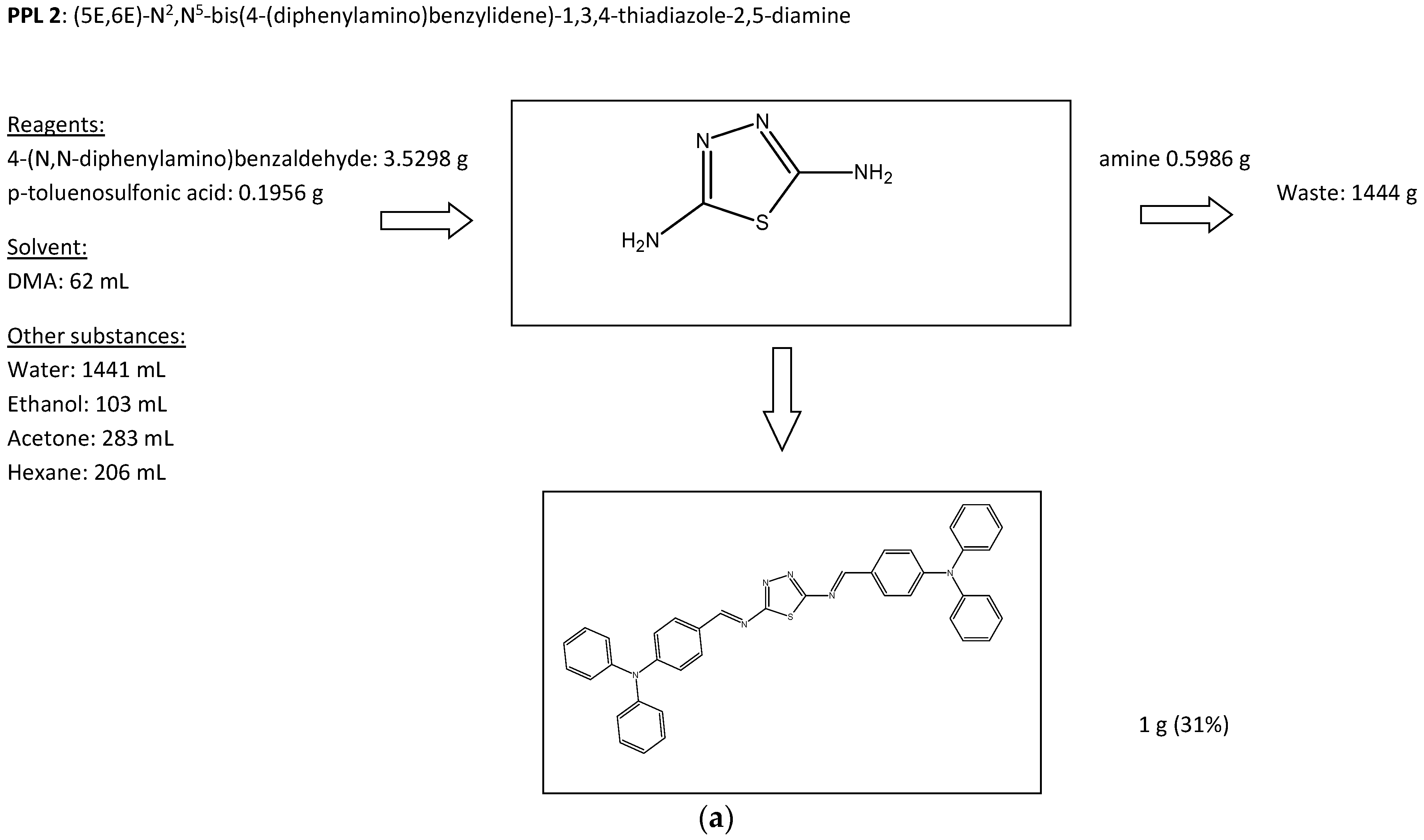
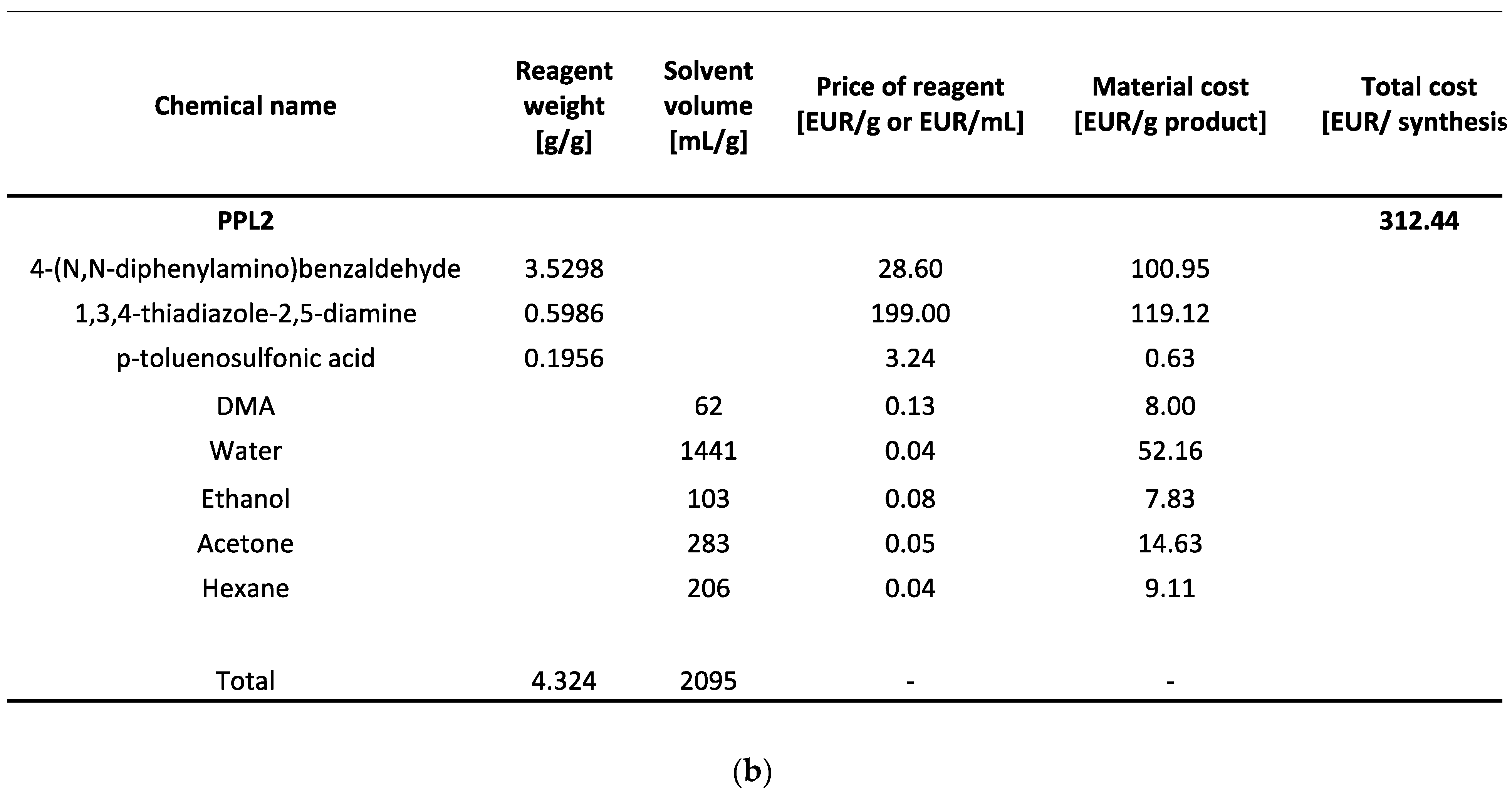
| Sample | Eoxonset [V] | Eredoffset [V] | HOMO [eV] | LUMO [eV] | EgCV [eV] | λabs [nm] in CHCl3 | Conductivity S/cm |
|---|---|---|---|---|---|---|---|
| PPL2 | 0.74 | −2.19 | −5.19 | −2.38 | 2.81 | 410 | 4.61 × 10−8 |
| PPL2:CSA(+) | 0.68 | −2.24 | −5.13 | −2.33 | 2.80 | 414, 510 | 4.16 × 10−8 |
| PPL2:CSA(−) | 0.70 | −2.31 | −5.15 | −2.26 | 2.89 | 412, 504 | 5.21 × 10−8 |
Disclaimer/Publisher’s Note: The statements, opinions and data contained in all publications are solely those of the individual author(s) and contributor(s) and not of MDPI and/or the editor(s). MDPI and/or the editor(s) disclaim responsibility for any injury to people or property resulting from any ideas, methods, instructions or products referred to in the content. |
© 2024 by the authors. Licensee MDPI, Basel, Switzerland. This article is an open access article distributed under the terms and conditions of the Creative Commons Attribution (CC BY) license (https://creativecommons.org/licenses/by/4.0/).
Share and Cite
Bogdanowicz, K.A.; Iwan, A.; Dysz, K.; Przybyl, W.; Marzec, M.; Cichy, K.; Świerczek, K. Air-Stable and Eco-Friendly Symmetrical Imine with Thiadiazole Moieties in Neutral and Protonated form for Perovskite Photovoltaics. Materials 2024, 17, 1909. https://doi.org/10.3390/ma17081909
Bogdanowicz KA, Iwan A, Dysz K, Przybyl W, Marzec M, Cichy K, Świerczek K. Air-Stable and Eco-Friendly Symmetrical Imine with Thiadiazole Moieties in Neutral and Protonated form for Perovskite Photovoltaics. Materials. 2024; 17(8):1909. https://doi.org/10.3390/ma17081909
Chicago/Turabian StyleBogdanowicz, Krzysztof Artur, Agnieszka Iwan, Karolina Dysz, Wojciech Przybyl, Monika Marzec, Kacper Cichy, and Konrad Świerczek. 2024. "Air-Stable and Eco-Friendly Symmetrical Imine with Thiadiazole Moieties in Neutral and Protonated form for Perovskite Photovoltaics" Materials 17, no. 8: 1909. https://doi.org/10.3390/ma17081909
APA StyleBogdanowicz, K. A., Iwan, A., Dysz, K., Przybyl, W., Marzec, M., Cichy, K., & Świerczek, K. (2024). Air-Stable and Eco-Friendly Symmetrical Imine with Thiadiazole Moieties in Neutral and Protonated form for Perovskite Photovoltaics. Materials, 17(8), 1909. https://doi.org/10.3390/ma17081909








